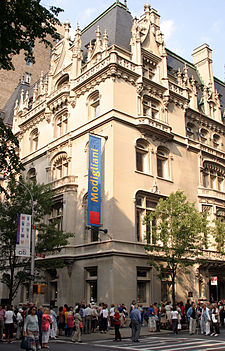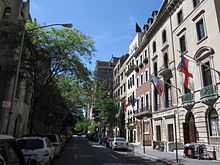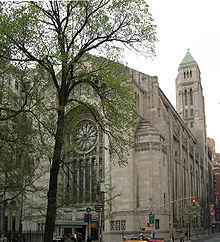- Upper East Side
-
This article is about the neighborhood in New York City. For the neighborhood in Miami, see Upper Eastside.
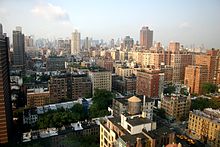 View from 96th Street looking south: Lexington Avenue angles up from the lower right corner
View from 96th Street looking south: Lexington Avenue angles up from the lower right corner One of many historicist buildings in the Upper East Side (45 East 66th Street as seen across Madison Avenue)
One of many historicist buildings in the Upper East Side (45 East 66th Street as seen across Madison Avenue)
The Upper East Side is a neighborhood in the borough of Manhattan in New York City, between Central Park and the East River. The Upper East Side lies within an area bounded by 59th Street to 96th Street, and the East River to Fifth Avenue-Central Park.[1] The ZIP codes included in this neighborhood are 10021, 10022, 10028, 10075, 10128, 10029 and 10065.
Once known as the 'Silk Stocking District',[2] it retains its position as one of the most affluent neighborhoods of New York City.
Contents
History
Before the arrival of Europeans, the mouths of streams[3] that eroded gullies in the East River bluffs are conjectured to have been the sites of fishing camps used by the Lenape, whose controlled burns once a generation or so kept the dense canopy of oak-hickory forest open at ground level.[4]
In the 19th century[5] the farmland and market garden district of what was to be the Upper East Side was still traversed by the Boston Post Road and, from 1837, the New York and Harlem Railroad, which brought straggling commercial development around its one station in the neighborhood, at 86th Street, which became the heart of German Yorkville. The area was defined by the attractions of the bluff overlooking the East River, which ran without interruption from James William Beekman's "Mount Pleasant", north of the marshy squalor of Turtle Bay, to Gracie Mansion, north of which the land sloped steeply to the wetlands that separated this area from the suburban village of Harlem.[6] Among the series of villas a Schermerhorn country house overlooked the river at the foot of present-day 73rd Street and another, Peter Schermerhorn's at 66th Street,[7] and the Riker homestead was similarly sited at the foot of 75th Street.[8] By the mid-19th century the farmland had largely been subdivided, with the exception of the 150 acres (0.61 km2) of Jones's Wood, stretching from 66th to 76th Streets and from the Old Post Road (Third Avenue) to the river[9] and the farmland inherited by James Lenox, who divided it into blocks of houselots in the 1870s,[10] built his Lenox Library on a Fifth Avenue lot at the farm's south-west corner,[11] and donated a full square block for the Presbyterian Hospital, between 70th and 71st Streets, and Madison and Park Avenues.[12] At that time, along the Boston Post Road taverns stood at the mile-markers, Five-Mile House at 72nd Street and Six-Mile House at 97th, a New Yorker recalled in 1893.[8]
The fashionable future of the narrow strip between Central Park and the railroad cut was established at the outset by the nature of its entrance, in the southwest corner, north of the Vanderbilt family's favored stretch of Fifth Avenue in the 50s.[13] A row of handsome townhouses was built on speculation by Mary Mason Jones, who owned the entire block bounded by 57th and 58th Streets and Fifth and Madison; in 1870 she occupied the prominent corner house at 57th and Fifth, though not in the isolation described by her niece, Edith Wharton:
"It was her habit to sit in a window of her sitting room on the ground floor, as if watching calmly for life and fashion to flow northward to her solitary door... She was sure that presently the quarries, the wooden greenhouses in ragged gardens, the rocks from which goats surveyed the scene, would vanish before the advance of residences as stately as her own."[14]
Wharton's picture has been uncritically accepted as history, Christopher Gray has pointed out.[15]
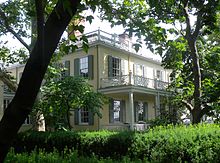 Gracie Mansion, last of the East River villas
Gracie Mansion, last of the East River villas
Before the Park Avenue railroad cut was covered (finished in 1910), fashionable New Yorkers shunned the smoky railroad trench up Fourth Avenue (now Park Avenue), to build stylish mansions and townhouses on the large lots along Fifth Avenue, facing Central Park, and on the adjacent side streets. The latest arrivals were the rich Pittsburghers Andrew Carnegie and Henry Clay Frick. The classic phase of Gilded Age Fifth Avenue as a stretch of private mansions was not long-lasting: the first apartment house to replace a private mansion on upper Fifth Avenue was 907 Fifth Avenue (1916), at 72nd Street, the neighborhood's grand carriage entrance to Central Park.[16]
Most members of New York's upper-class families have made residences on the Upper East Side, including the oil-rich Rockefellers,[17] political Roosevelts,[18] political dynastic Kennedys, [19][20] thoroughbred racing moneyed Whitneys,[21][22] and tobacco and electric power fortuned Dukes.[23]
Construction of the 3rd Avenue El, opened from 1878 in sections, followed by the 2nd Avenue El, opened in 1880, linked the Upper East Side's middle class and skilled artisans closely to the heart of the city, and confirmed the modest nature of the area to their east. The ghostly "Hamilton Square", which had appeared as one of the few genteel interruptions of the grid plan on city maps since the Commissioners' Plan of 1811, was intended to straddle what had now become the Harlem Railroad right-of-way between 66th and 69th Streets; it never materialized, though during the Panic of 1857 its unleveled ground was the scene of an open-air mass meeting called in July to agitate for the secession of the city and its neighboring counties from New York State, and the city divided its acreage into house lots and sold them.[24] From the 1880s Yorkville, as it was known, extended eastwards toward the river and westwards past Lexington Avenue; Yorkville became a suburb of middle-class Germans, many of whom worked in nearby piano factories, stables, and breweries.
Gracie Mansion, the last remaining suburban villa overlooking the East River, became the home of New York's mayor in 1942. The East River Drive, designed by Robert Moses, was extended southwards from the first section, from 125th Street to 92nd Street, which was completed in 1934 as a boulevard, an arterial highway running at street level; reconstruction designs from 1948 to 1966 converted FDR Drive, as it was renamed after Franklin Delano Roosevelt, into the full limited-access parkway that is in use today.
Demolishing the els on Third and Second opened the avenues of tenements to the spotty construction of high-rise apartment blocks from the 1950s.
Geography
Generally speaking, the Upper East Side stretches from 59th Street to 96th Street (in the zip codes of 10021, 10022, 10065, 10075, 10028, and 10128). [25]
Many realtors used the term "Upper East Side" instead of "East Harlem" to define areas that are north of 96th street such as on 5th ave or areas close by such as 97th street to avoid the negative connotation since people associate the latter with being a less prestigious neighborhood.[26] However, zip codes 10029 and the elected officials that represent East Harlem never cross 96th street and they do not refer to their neighborhoods as being part of the Upper East Side. On the other hand, according the NY Department of Buildings, Upper East Side actually extends from 97th St. up to 110th St. if you are residing in the areas between Central Park 5th Avenue and Madison Avenue. [27]
Its north-south avenues are Fifth Avenue, Madison Avenue, Park Avenue, Lexington Avenue, Third, Second and First Avenues, York Avenue, and East End Avenue (the latter runs only from East 79th Street to East 90th Street).
Demographics
As of the 2000 census, there were 207,543 people residing in the Upper East Side. The population density was 118,184 people per square mile (45,649/km²), making Manhattan Community Board 8, coterminous with the Upper East Side, the densest Community Board in the city.[28] The racial makeup of the neighborhood was 88.25% White, 6.14% Asian, 0.04% Pacific Islander, 2.34% African American, 0.09% Native American, 1.39% from other races, and 1.74% from two or more races. 5.62% of the population were Hispanic of any race. Twenty-one percent of the population was foreign born; of this, 45.6% came from Europe, 29.5% from Asia, 16.2% from Latin America and 8.7% from other. The female-male ratio was very high with 125 females for 100 males.[29]
Given its very high population density and per capita income ($85,081 in 2000), the neighborhood is believed to contain the greatest concentration of individual wealth in the world.[citation needed] As of 2000, 75.6% of adults (25+) had attained a bachelor's degree or higher.
Politics
The Upper East Side is one of few areas of Manhattan where Republicans constitute more than 20% of the electorate. In the southwestern part of the neighborhood Republican voters equal Democratic voters (the only such area in Manhattan), whereas in the rest of the neighborhood Republicans make up between 20 and 40% of registered voters.[30]
The Upper East Side is also notable as a significant location of political fundraising in the United States. Four of the top five ZIP codes in the nation for political contributions are in Manhattan. The top ZIP Code, 10021, is on the Upper East Side and generated the most money for the 2004 presidential campaigns of both George W. Bush and John Kerry.[31]
Economy
Many diplomatic missions are located in former mansions on the Upper East Side. The Consulate-General of France in New York is located at 934 Fifth Avenue between 74th Street and 75th Street.[32] The Consulate-General of Greece in New York is located at 69 East 79th Street (10021), occupying the former George L. Rives residence. The Consulate-General of Italy in New York is located at 690 Park Avenue(10065).[33] The Consulate-General of India in New York is located at 3 East 64th Street between 5th Avenue and Madison Avenue.[34] The Consulate-General of Pakistan in New York is located at 12 East 65th Street (10065).[35]
Missions to the United Nations in the Upper East Side include:[36]
Cost of living
The Upper East Side maintains one of the highest pricing per square foot in the United States. A 2002 report cited the average cost per square foot as $856; however, that price has noticed a substantial jump, increasing to almost as much as $1,200 per square foot as of 2006.[37][38]
The only public housing projects for those of low to moderate incomes on the Upper East Side are located just below the neighborhood's northern limit at 96th Street, the Holmes Towers and Isaacs Houses.
Government and infrastructure
The United States Postal Service operates post offices at Lenox Hill Station (10021), 221 East 70th Street; Cherokee Station (10075), 1483 York Avenue;[39] Gracie Station (10028), 229 East 85th Street;[40] and Yorkville Station (10128), 1617 3rd Avenue.[41] [1] [2] New Zip codes now include 10065 and 10075
Transportation
The Upper East Side is currently served by one subway line, the four-track IRT Lexington Avenue Line (4 5 6 <6> trains), and local bus routes. Due to severe congestion on the subway and buses, the Metropolitan Transportation Authority is currently building a new subway line, the Second Avenue Subway, along Second Avenue. The first phase will run from 96th Street to 63rd Street, where it will physically connect with the BMT Broadway Line; service will be provided by a northern extension of the Q train. In later phases, the line will be extended north to 125th Street/Park Avenue in Harlem and south to Hanover Square in the Financial District, and a new T train will run its entire length.
Landmarks and cultural institutions
The area is host to some of the most famous museums in the world. The string of museums along Fifth Avenue fronting Central Park has been dubbed "Museum Mile." It was once named "Millionaire's Row." Among the cultural institutions on the Upper East Side:
- 92nd Street Y
- The Asia Society
- Cooper–Hewitt, National Design Museum
- The Frick Collection
- Goethe-Institut New York
- The Jewish Museum of New York
- The Metropolitan Museum of Art
- El Museo del Barrio
- The Museum of the City of New York
- The Morgan Library & Museum
- The National Academy of Design
- Manhattan House, the Skidmore, Owings and Merrill designed mid-century modernist white brick building at 200 E 66th Street, once home to Grace Kelly and Benny Goodman. Landmarked in 2007 [42]
- The Neue Galerie
- Society of Illustrators
- The Solomon R. Guggenheim Museum
- The Whitney Museum of American Art
- The Irish Georgian Society
- Political institutions
- Hotels
- Plaza Hotel (technically in Midtown)
- The Carlyle Hotel
- The Pierre
- Bentley Hotel
Houses of worship
- Church of the Heavenly Rest, an Episcopal Church
- Congregation Kehilath Jeshurun, a Modern Orthodox synagogue
- Congregation Or Zarua, a Conservative synagogue
- Edmond J. Safra Synagogue, an Orthodox Sephardic synagogue
- Fifth Avenue Synagogue, an Orthodox synagogue
- Jan Hus Presbyterian Church
- Park Avenue Christian Church, a Disciples of Christ church
- Park Avenue Synagogue, a Conservative Jewish congregation
- Park East Synagogue, an Orthodox synagogue
- St. John the Martyr's Church, a Roman Catholic church
- Temple Emanu-El of New York, a Reform synagogue
- Temple Israel, a Reform synagogue
- Islamic Cultural Center of New York, Mosque
Education
Primary and secondary schools
Private schools
- Girls' schools
- The Brearley School
- The Chapin School
- The Convent of the Sacred Heart
- Dominican Academy
- The Hewitt School
- Manhattan High School for Girls
- Marymount School
- St. Vincent Ferrer High School
- Nightingale-Bamford School
- Spence School
- St. Jean Baptiste High School
- Boys' schools
- Allen-Stevenson School
- The Browning School
- The Buckley School
- St. Bernard's School
- St. David's School
- Regis High School
- Coeducational schools
- Birch Wathen Lenox School
- Caedmon School
- Dalton School
- Loyola School
- Lycée Français de New York
- La Scuola d'Italia Guglielmo Marconi
- Park East School
- Rudolph Steiner School
- The Town School
- Trevor Day School
- Ramaz School
- Islamic Cultural Center School
Public schools
New York City Department of Education operates area public schools.
- Public lower and middle schools
- PS 183 (Robert Louis Stevenson School)
- PS 77 The Lower Lab school
- East Side Middle School
- PS 6 (Lillie Devereux Blake School)
- PS 158 (East Side Middle School)
- Senator Robert F. Wagner Middle School (JHS 167)
- Public high schools
- Other Schools
Colleges and universities
- Cornell University Medical School
- Hunter College
- Marymount Manhattan College
- Mount Sinai School of Medicine
- Rockefeller University
- Metropolitan Hospital (NY Medical College)
- New York School of Interior Design
- Lenox Hill Hospital
JHS 22 Houston St Lower East Side
Public libraries
The New York Public Library operates the 67th Street Branch Library at 328 East 67th Street, near First Avenue,[43] the Yorkville Branch Library, 222 East 79th Street and the 96th Street Branch Library at 112 East 96th Street, near Lexington Avenue.[44]
In popular culture
The Upper East Side has been a setting for many movies, television shows, and many other media due to its world-class museums, expensive restaurants and boutiques, proximity to Central Park, elite schools, and influential residents.
Movies
- Breakfast at Tiffany's (1961)
- The Boys in the Band (1970)
- Live and Let Die (1973)
- The Great Gatsby (1974)
- Kramer vs. Kramer (1979)
- Manhattan (1979)
- The Muppets Take Manhattan (1984)
- Family Business (1989)
- The Bonfire of the Vanities (1990)
- Metropolitan (1990)
- Juice (1992)
- Six Degrees of Separation (1993)
- Manhattan Murder Mystery (1993)
- Harriet the Spy (1996
- Ransom (1996)
- One Fine Day (1996)
- The Devil's Advocate (1997)
- Men in Black (1997)
- A Perfect Murder (1998)
- Cruel Intentions (1999)
- Thomas Crown Affair (1999 film) (1999)
- Eyes Wide Shut (1999)(Although this film purports to depict the UES, the film's principal photography with all the actors and actresses was done in the UK. Including the scenes, where the Tom Cruise character was seen walking around were in fact all sound stages.) [45][46]
- Autumn in New York (2000)
- American Psycho (2000)
- Tart (2001)
- The Princess Diaries (2001)
- 25th Hour (2002)
- Uptown Girls (2003)
- The Producers Roger De Bris townhouse. (2005)
- The Nanny Diaries (2007)
- Two Weeks Notice (2002)
- The Bourne Ultimatum (2007)
- The Devil Wears Prada (2007)
- Sex and the City: The Movie (2008)
- Ghost Town (2008)
- Made of Honor (2008)
- The Wackness (2008)
- The Women (2008)
- Bride Wars (2009)
- Confessions of a Shopaholic (2009)
- Percy Jackson & the Olympians: The Lightning Thief (2010)
- The Back-up Plan (2010)
- Sex and the City 2 (2010)
- Twelve (2010)
- Remember Me (2010 film) (2010)
TV
- Show Me The Manny (2010–)
- Kourtney and Kim Take New York (2011–)
- Friends (1994–2004)
- Gossip Girl (2007–)
- Lipgloss (2008–)
- Ang Pangarap Kong Jackpot
- Calel Gosingtian (2010–)
- How I Met Your Mother (2005–)
- The Jeffersons (1975–1985)
- Diff'rent Strokes (1978–1986)
- The Nanny (1993–1999)
- Sex and the City (1998–2004)
- Will & Grace (1998–2006)
- Lipstick Jungle (2008–2009)
- Dirty Sexy Money (2007–2008)
- Daria (1997–)
- Ugly Betty (2006–2010)
- Road to High School Musical 2 (2007)
- New York Twinx (2010–)
- The Real Housewives of New York City (2008–)
- NYC Prep (2009–)
- High Society (2010–)
- Sesame Street (1969–) (Various clues over the years suggest this)
Books
- Breakfast at Tiffany's by Truman Capote
- The Princess Diaries by Meg Cabot
- The Catcher in the Rye by J. D. Salinger
- American Psycho by Bret Easton Ellis
- The Bonfire of the Vanities by Tom Wolfe
- The Bourne Identity by Robert Ludlum
- Gossip Girl Series by Cecily von Ziegesar
- Gossip Girl: The Carlyles by Cecily von Ziegesar
- The Great Gatsby by F. Scott Fitzgerald
- The Nanny Diaries by Nicola Kraus and Emma McLaughlin
- The Up and Comer by Howard Roughan
- The A-List by Zoey Dean
- The Au-Pairs and Blue Blood Novels by Melissa de la Cruz
- Harriet the Spy by Louise Fitzhugh
- Percy Jackson & the Olympians by Rick Riordan
- Chronic City by Jonathan Lethem
- The Analyst by John Katzenbach
- The Luxe by Anna Godbersen
- Shopaholic Takes Manhattan by Sophie Kinsella
- Blue Bloods by Melissa de la Cruz
Fictional places
- Treadstone Seventy-One
- Constance Billard School for Girls
- St. Jude's School for Boys
- The Empire Hotel
- The Duchesne School
Notable residents
The neighborhood has a long tradition of being home to some of the world's most wealthy, powerful and influential families and individuals. Some of the notable people who have lived here include:
- Woody Allen, film director, screenwriter, and actor[47]
- Lady Gaga, Multiple Grammy-Award winning Singer/Songwriter and Performance Artist, grew up on the Upper East Side.
- Joan Didion, Award-winning author
- Jonathan Franzen, Pulitzer prize-winning novelist
- Gerald Garson, former NY Supreme Court Justice convicted of accepting bribes to manipulate outcomes of divorce proceedings
- Sarah Michelle Gellar, Award-winning actress
- Caroline Kennedy, daughter of U.S. President John F. Kennedy
- Brooke Astor, philantropist and widow of Vincent Astor.
- Spike Lee, Emmy Award-winning director
- Madonna purchased $40 million mansion on East 81st Street at Lexington Avenue in 2009
- Barbara Margolis, prisoners' rights advocate who served as official greeter of New York City.[48]
- Malachi Martin, best-selling author
- Ricky Gervais, comedian
- Jacqueline Kennedy Onassis, former First Lady
- Lynn Pressman Raymond, toy and game innovator who was president of the Pressman Toy Corporation[49]
- Martin Scorsese, Academy Award-winning film director
- Eliot Spitzer, former governor of NY State
- Jamie Dimon
- Robert I. Lipp
- Jay S. Fishman
- David Koch
- Michael Bloomberg
- Massimo & Lella Vignelli[50]
See also
References
- ^ "Upper East Side." New York. Retrieved on January 26, 2009; an uptown edge at 110th Street is maintained by "www.ny.com "New York City Geographical Information". Retrieved on May 7, 2009; Mount Sinai School of Medicine "a 950-bed urban teaching hospital located on the boundary between the upper East Side of Manhattan and East Harlem" ("Medical Errors Related to Discontinuity of Care from an Inpatient to an Outpatient Setting", 2003).
- ^ The City Review Upper East Side, the Silk Stocking District
- ^ Noted at East 53rd, 62nd, 74th Streets (the Saw Kill, dammed to form the Lake in Central Park) and 80th Street (Eric W. Sanderson, Mannahatta: A Natural History of New York City, 2009, p. 261`"Lenape sites and place-names").
- ^ A reconstructed map of the patchwork ecologies of Manhattan island before Europeanization is presented in Sanderson 2009; map p. 139.
- ^ The history of the Upper East Side, in the broader citywide context, is repeatedly noted in Edwin G. Burrows and Mike Wallace, Gotham: A History of New York City to 1898 (1999).
- ^ The original ecology of Manhattan Island and its evolution is now thoroughly explored in Eric W. Sanderson, Mannahatta: A Natural History of New York City (New York: Abrams, 2009), based in part on a British army map detailing the island's natural terrain at the time of the American Revolution.
- ^ In 1818, with a purchase to the south, Peter Schermerhorn enlarged the property given him by his father-in-law, John Jones (FindaGrave: Peter Schermerhorn, based on "History of the Schermerhorn family", The New York Genealogical and Biographical Record,, 36 (July 1905:204)), now the site of Rockefeller University (Rockefeller University: history).
- ^ a b ""Early New York History: Old Days In Yorkville And Harlem", 1893". Oldandsold.com. http://www.oldandsold.com/articles11/new-york-history-20.shtml. Retrieved May 12, 2011.
- ^ Jones's Wood, owned by the Joneses and their Schermerhorn cousins and operated as a popular beer-garden resort, was briefly touted as a possible location for a public park before Central Park was established (Roy Rosenzweig and Elizabeth Blackmar, The Park and the People: A History of Central Park, New York, 1992, pp 20–21, map p. 38, et passim).
- ^ "Realty Romance in Old Lenox Farm", The New York Times, December 15, 1918]; the occasion was the auction of the auction sale an 1874 map of the section of Robert Lenox's farm, bought in 1818 that lay between 71st and 74th Streets, from Fifth Avenue to the railroad right-of-way that became Park Avenue.
- ^ When the library was consolidated with Astor and Tilden trusts to form the New York Public Library, a unique block-long stretch of Fifth Avenue frontage was liberated for the latecomer Henry Clay Frick to build his grand residence, now the Frick Collection.
- ^ "Founded by James Lenox, the chief features of the Presbyterian hospital..." The New York Times, July 3, 1892.
- ^ Arthur T. Vanderbilt 2nd, Fortune's Children: The Fall of the House of Vanderbilt (New York, 1989).
- ^ Wharton, The Age of Innocence.
- ^ Gray, "Streetscapes: "Edith Wharton; In 'The Age of Innocence,' Fiction Was Not Truth'" The New York TimesAugust 27, 1995.
- ^ "The Upper East Side Book: 907 Fifth Avenue". Thecityreview.com. July 31, 2010. http://www.thecityreview.com/ues/fifave/fif907.htm. Retrieved May 12, 2011.
- ^ "The Upper East Side Book: Fifth Avenue: 834 Fifth Avenue". Thecityreview.com. http://www.thecityreview.com/ues/fifave/fif834.htm. Retrieved May 12, 2011.
- ^ "Home". Brown Harris Stevens. http://www.brownharrisstevens.com/detail.aspx?id=761468. Retrieved May 12, 2011.
- ^ [1][dead link]
- ^ "Clos Mimi". Clos Mimi. March 22, 2007. http://www.closmimi.com/carlylehotel.php. Retrieved May 12, 2011.
- ^ "The Upper East Side Book: Fifth Avenue: 1125 Fifth Avenue". Thecityreview.com. http://www.thecityreview.com/ues/fifave/fif1125.htm. Retrieved May 12, 2011.
- ^ "NATIVES OF NEW YORK STILL OWN UPPER FIFTH AVENUE - In Spite of the Influx of Outsiders, Knickerbocker Families Easily Remain In the Ascendant. The Majority, Who Are Not Knickerbockers, Hail from New England and the Eastern States. - View Article - NYTimes.com". New York Times. May 26, 1907. http://query.nytimes.com/mem/archive-free/pdf?_r=1&res=9F06E1D7163EE033A25755C2A9639C946697D6CF&oref=slogin. Retrieved May 12, 2011.
- ^ "at". Divasthesite.com. http://www.divasthesite.com/Society_Divas/doris_duke_a.htm. Retrieved May 12, 2011.
- ^ Edwin G. Burrows and Mike wallace, Gotham: a history of New York City to 1898, 1999, pp. 421, 840, 849.
- ^ "Manhattan Community Data by Zip Code | Manhattan Chamber of Commerce. We Mean Business. New York, NY". Manhattancc.org. http://www.manhattancc.org/common/news/reports/detail.cfm?Classification=news&QID=7330&ClientID=11001&topicID=541. Retrieved May 12, 2011.
- ^ "Is the Upper East Side Moving North? – New York Times". Nytimes.com. January 31, 1988. http://www.nytimes.com/1988/01/31/realestate/is-the-upper-east-side-moving-north.html?pagewanted=1. Retrieved May 12, 2011.
- ^ "Zip Code 10029: East Harlem | Manhattan Chamber of Commerce. We Mean Business. New York, NY". Manhattancc.org. http://www.manhattancc.org/common/news/reports/detail.cfm?Classification=report&QID=7247&ClientID=11001&TopicID=283. Retrieved May 12, 2011.
- ^ UPPER EAST SIDE – CD 308[dead link]
- ^ "Social Explorer 2000 Demography Map: Median Income in Upper East Side". Socialexplorer.com. http://www.socialexplorer.com/pub/maps/map3.aspx?g=0&mapi=SE0012&themei=767694.920954384.6460.988&l=2283243.52287408&r=2291023.93491898&t=5256165.51580534&b=5251538.1864453&rndi=1. Retrieved May 12, 2011.
- ^ "Who Are NYC's Republicans?". Gothamgazette.com. http://www.gothamgazette.com/article/demographics/20040126/5/853. Retrieved May 12, 2011.
- ^ Big Donors Still Rule The Roost, accessed July 18, 2006.
- ^ "Contact & hours of operation." Consulate-General of France in New York. Retrieved on January 26, 2009.
- ^ "Welcome to the website of the Consulate General of Italy in New York." Consulate-General of Italy in New York. Retrieved on January 26, 2009.
- ^ "Contact Us." Consulate-General of India in New York. Retrieved on January 26, 2009.
- ^ Home. Consulate-General of Pakistan in New York. Retrieved on January 26, 2009.
- ^ "United Nations Member States." United Nations. Retrieved on January 26, 2009.
- ^ Hevesi, Dennis. " Residential Real Estate; TriBeCa Is Priciest Neighborhood", The New York Times, May 17, 2002. Accessed June 7, 2007.
- ^ "Charts". Miller Samuel. February 14, 2011. http://www.millersamuel.com/charts/gallery-view.php?ViewNode=1155055479AKfgw&Record=33. Retrieved May 12, 2011.
- ^ "Post Office Location – Cherokee." United States Postal Service. It is important to note that zip code 10021 which was a widely used zip code and spoken as an "prestigious zip code indicating status" was recently split up by the post office Retrieved on January 30, 2009.
- ^ "Post Office Location – Gracie." United States Postal Service. Retrieved on January 30, 2009.
- ^ "Post Office Location – Yorkville Station." United States Postal Service. Retrieved on January 30, 2009.
- ^ http://www.nyc.gov/html/lpc/downloads/pdf/press/10_30_07-30.pdf
- ^ "67th Street Branch Library." New York Public Library. Retrieved on January 30, 2009.
- ^ "9th Street Branch Library." New York Public Library. Retrieved on January 30, 2009.
- ^ http://www.imdb.com/title/tt0120663/locations
- ^ http://www.imdb.com/title/tt0120663/trivia
- ^ Day, Sherri. "Disappointment for Woody Allen, but Not at Box Office", The New York Times, March 26, 2004. Accessed November 30, 2007. "The state's highest court yesterday dismissed an effort to halt construction of a 10-story building on the Upper East Side, ending a six-year battle that pitted Woody Allen and a group of fellow Upper East Siders against the city's Landmarks Preservation Commission."
- ^ "Barbara Margolis, Prisoners’ Advocate, Dies at 79", The New York Times, July 12, 2009. Accessed July 21, 2009.
- ^ Grimes, William. "Lynn Pressman Raymond, Toy Executive, Dies at 97", The New York Times, August 1, 2009. Accessed August 2, 2009.
- ^ Lovine, Julie V. (October 21, 2007). ""Cross-Media Impresarios Massimo and Lella Vignelli – Design 2007 – New York Magazine"". Nymag.com. http://nymag.com/homedesign/fall2007/39597/. Retrieved May 12, 2011.
External links
Community interest sites
Coordinates: 40°46′09″N 73°57′56″W / 40.76917°N 73.96556°W
Categories:
Wikimedia Foundation. 2010.


